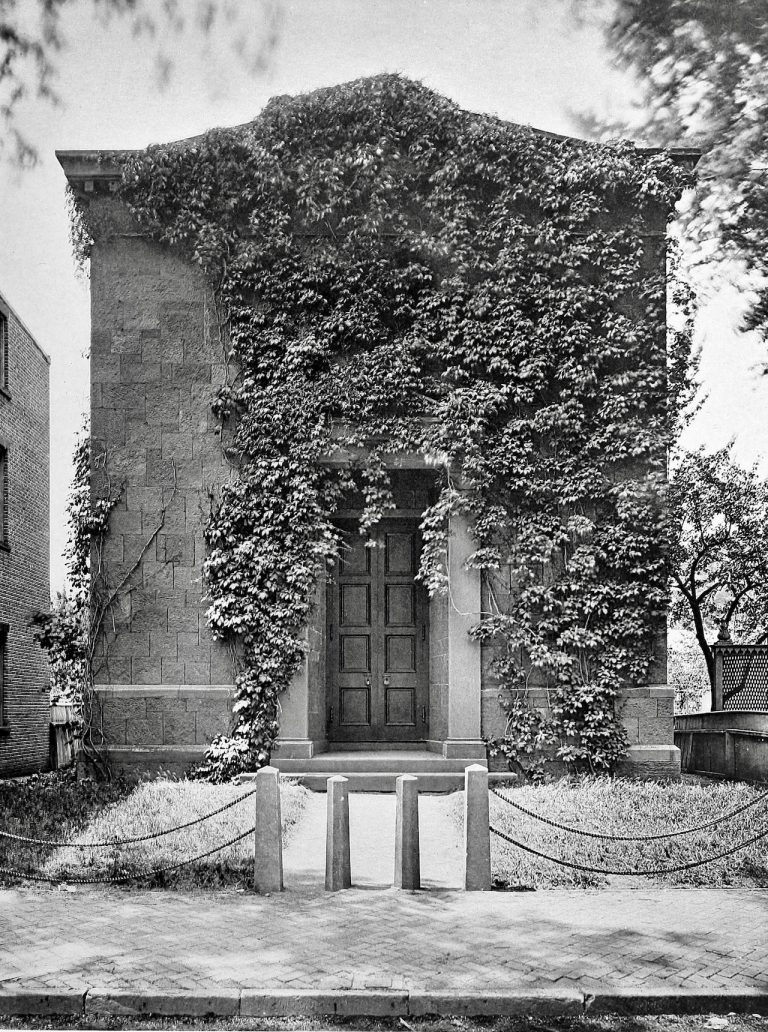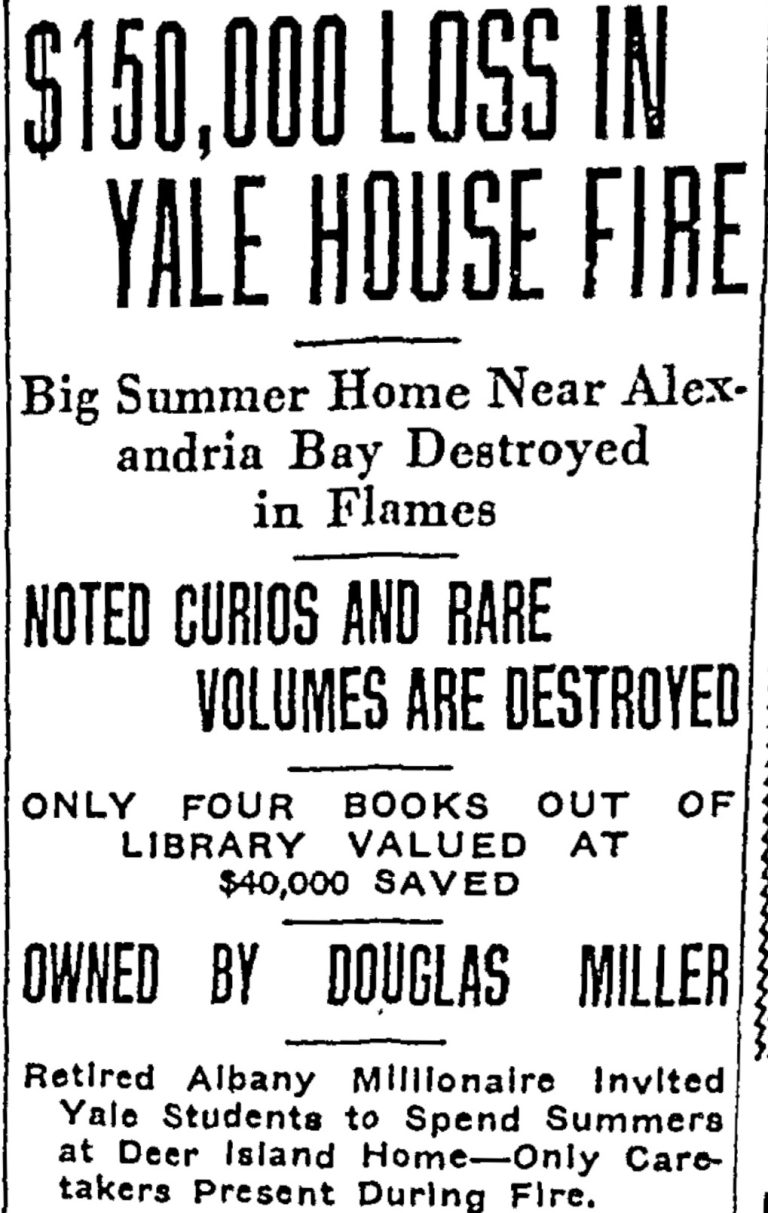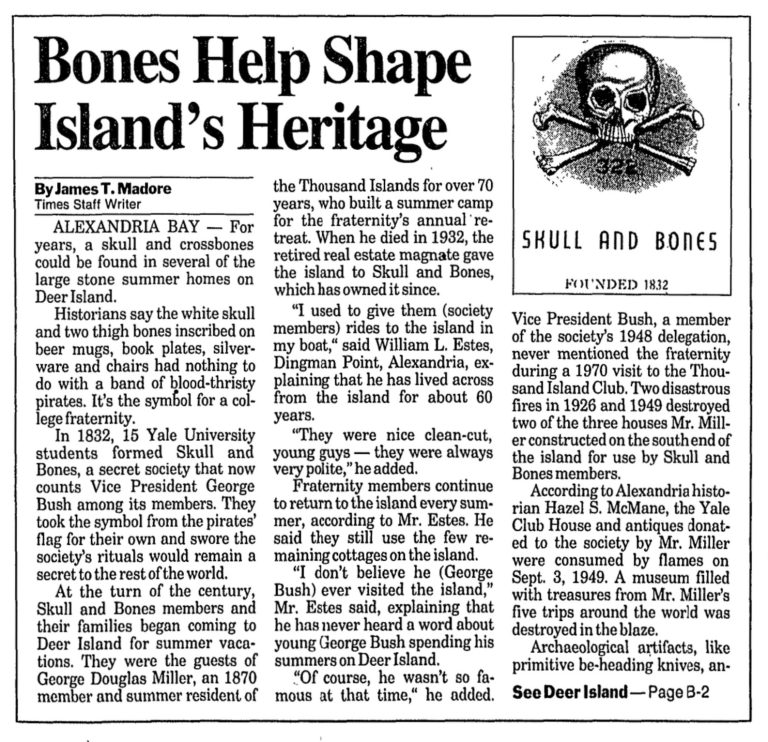Yale Alumnus George Douglas Miller Bequeaths Deer Island To Skull and Bones Upon Death, Decades After Secret Society Established Deer Island Club Association There In 1908
George Douglas Miller had been going to Deer Island since his father, Judge Samuel Miller of Albany, purchased the island from John K. Thompson for $10 back in 1858. The younger Miller, an 1870 Yale alumnus and member of the Skull and Bones secret society, retired as a millionaire, having been a lawyer and dealings in real estate.

The Order of the Skull and Bones dates back to its creation in 1832. It was co-founded by William Huntington Russell, Frederick Ellsworth Mather, Phineas Timothy Miller, George Ingersoll Wood, and Alphonso Taft, father of President William Howard Taft, one of many notable and key figures of American politics, military, and business to belong to the society, including Frederick Wallace Smith, who founded FedEx. A complete and exhaustive list of members by decade can be found here.
Insider’s list of the thirteen most powerful members can be found here.
After his father’s death, George inherited Deer Island, just under a mile and a half downriver from Alexandria Bay. By the early 1900s, he began using it and its several large homes as a retreat for the secretive Yale Skull and Bones society, also known as The Order, Order 322, and The Brotherhood of Death (its members are called “Bonesmen.”)

An article published in the Watertown Daily Times on Dec. 6, 1909, gave some additional information on George Douglas Miller’s involvement–
Cranks have been defined as “things that make the wheels go round,” and if the mechanism of this society gets clogged it will probably not be while George Douglas Miller is a part of it. He has not only always been obsessed by a fervent devotion to the Skull and Bones, but has done everything in his power to perpetuate its history and strengthen its bonds. He has not only collected a vast amount of the society’s memorabilia, but in his travels around the world has collected anything which has seemed to him to have the remotest bearing on its workings.
It becomes necessary in the course of time to have these things properly housed. The result was a group of mysterious buildings on this island of mysteries. His own private residence is at the north of the island. The south half is leased to the Deer Island Association. There are at present three buildings—one a club house for men alone, one where men may bring their wives and daughters, and a third is a vast stone structure, the principal feature of which is a great baronial hall, for which there is apparently no purpose. But the secrets of the society are as deep as the secrets of the sea, and as closely guarded.

It was in 1908 that the Deer Island Club was formed as a corporation under the parent company, the Russell Trust Association, of which the Skull and Bones was also incorporated. The articles of the Deer Island Corporation were as follows:
Article 1. The name of said corporation shall be “The Deer Island Club Corporation.”
Article II. The purpose for which said corporation is formed are the following: to wit:—to promote the social intercourse of its members, and to provide for them facilities for recreation and social enjoyment; and to this end, to purchase, hold and convey and property, real or personal, which may be necessary or convenient therefor; to maintain a Club House for the use and benefit of its members; and to adopt suitable by-laws and generally to exercise all the usual powers of corporations not prohibited by said matters.
Article III. The member of said corporation shall be the subscribers, and such persons as may from time to time be elected or constituted members under the by-laws adopted by said corporation. Dated at New Haven, Conn., this 18th day of February, A. D. 1907.
William Beebe
Henry W. Farnam
Gustav Gruener
J. C. Schwab
Heathcote M. Woolsey

Annual dues of members were $10/year. A $2.00 charge was assessed for members and ladies, the ladies using their separate facility (noted later.) Non-members were also welcome but assessed a $2.50 charge per day. If non-members daily charges amounted to $10.00, they would be included in the membership. During the previous summer, 68 persons visited Deer Island, most remaining for two weeks, which became the norm over the years, especially for those selected to attend an initiation phase.
Deer Island had, at the time, three major facilities: The “Ledges,” the “Overlook,” and the “Stone House.”
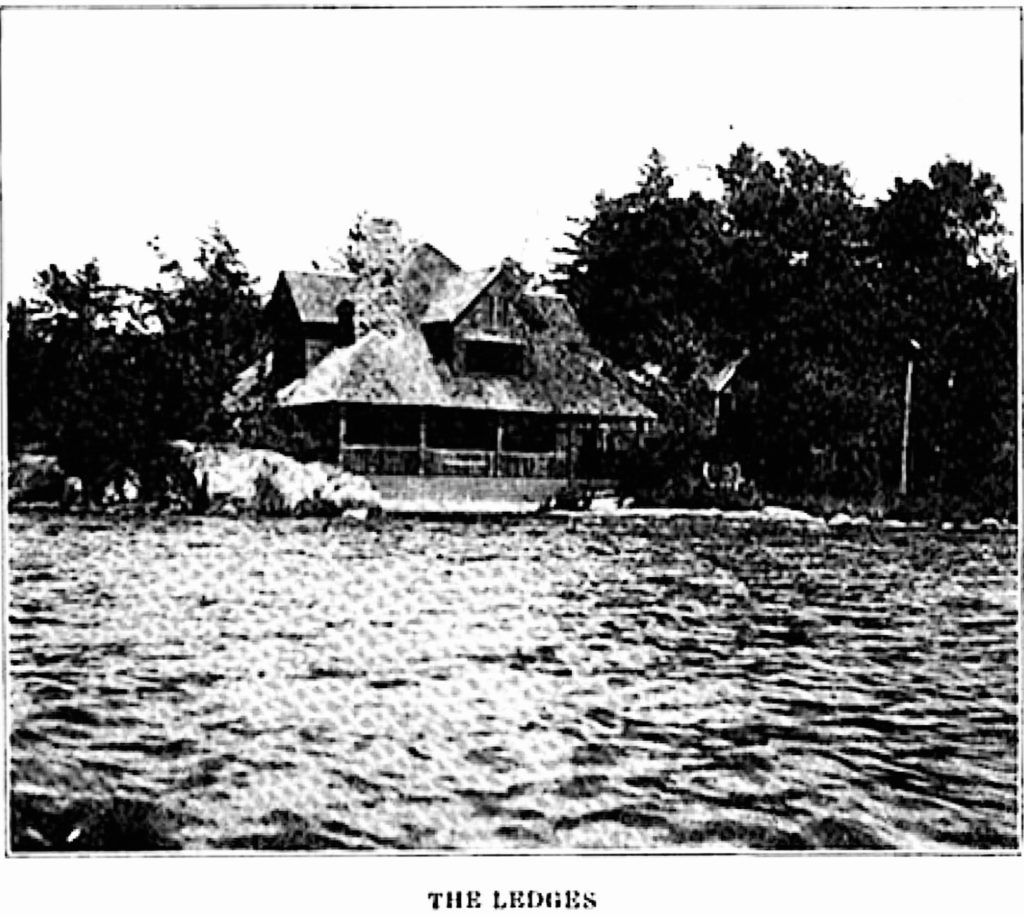
The Ledges
Located at the southern end of Deer Island, this is the only remaining facility of the three originally and still used by the Skull and Bones. The Ledges were used primarily for guests, whether wives, family members, or friends, and conveniently located less than a half mile from the main clubhouse. The Ledges had, in 1908, nine bedrooms and a large social room surrounded by a wide veranda. It also had a dining room and a boathouse.
According to an article in the Watertown Daily Times on December 6, 1909, the managing director of the association, William Beebe, professor of mathematics at Yale, and Mrs. Beebe, lived at the Ledges. The article also went on to detail The Ledges further–
It is said that the house has a choice collection of tableware, linen and furniture, all designed in the weird symbols of the skull and bones, and that the walls of its rooms are covered with pictures, portraits and texts commemorative of the fraternity’s history. The men are summoned to meals by a mysterious bell, three taps upon which are followed by twice two taps, “322” being the symbol which appears in everything connected with society, the exact significance of which is unknown to those outside.

The Outlook
The Outlook was the Skull and Bones main clubhouse at the island’s eastern end, a rocky bay bordering one side while the St. Lawrence River was at its front. Each of The Outlook’s fifteen bedrooms had hot and cold water and was furnished uniquely, with seven having open balconies overlooking the river. Dining and lounging rooms were also available, with the main hall filled with curios and mementos from the world over by George Douglas Miller.
The December 1909 Watertown Daily Times article also provided some additional information regarding The Outlook–
At present the most interesting house, the Outlook, is the club for men. Surrounded by trees, little of this is visible to those who pass by on the river, although the pleasure craft almost graze a corner of the overhanging porch.

Beside this, the casual observer sees a sloping roof and windows rising from the piazza, but he does not see or get any idea of a very handsome stone library building back of, where the men live. This library is filled with valuable works of art and material bearing upon the Skull and Bones. The house itself has every convenience and is open to all members of the association during the summer months.
The Outlook was the first building of two lost to fire over the years, burning on July 15, 1926. The loss was reported at $150,000, the fire also destroyed the annex that housed many of the curios and antiques George Douglas Miller collected over the decades. The collection was valued at $75,000, with only four volumes from the library valued at $40,000 salvaged and a few pieces of furniture from a $25,000 collection lost in the fire.
A chimney running through the portion of the house is believed to be the fire’s origin from a defective flue.

The Stone House
This was located about 100 yards from The Outlook, close to the shore, and “in a heavily wooded dell,” according to the society’s handbook published in 1908, which went on to describe it further–
It is a large building of native stone with a Flemish roof. In the lower part is a great hall (not yet finished.) Its walls are to be hung with a collection of ancient armor which is now in the keeping of the Albany Historical Society.
At the rear of the hall is a gallery, and on the floor above it is a suite of six bed rooms with several baths, while on the floor above that is a similar suite of five bed rooms, surrounded by a gallery, which comes well above the tree tops and looks out on a magnificent view.
The Stone House was the second structure to be lost to fire in the early morning of September 3, 1949. Total damages could not be determined, but much like the first fire, as noted below, several valuable items were lost.
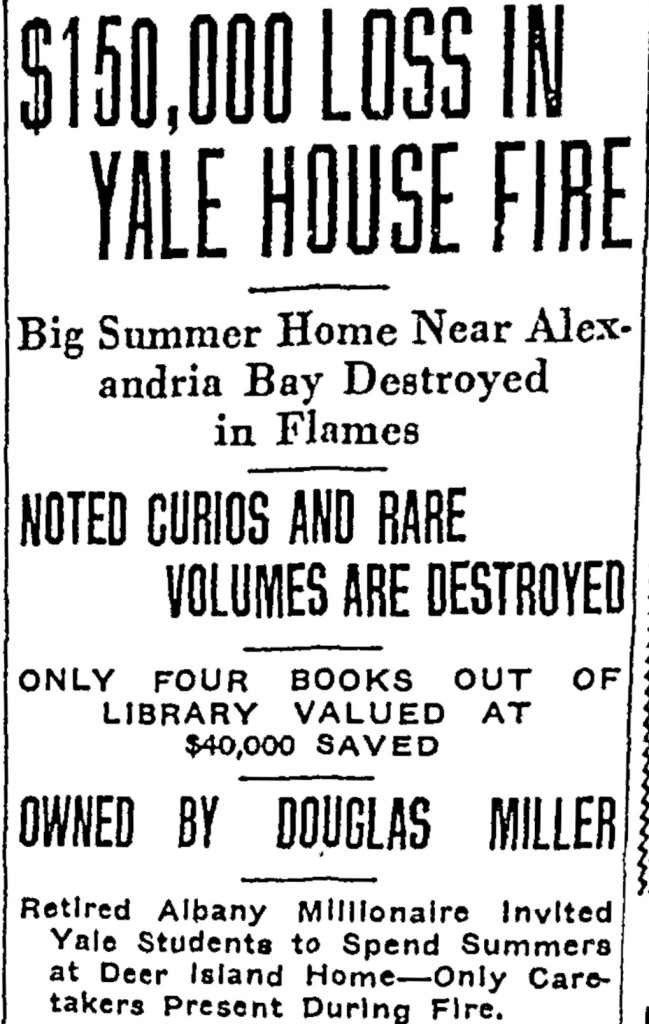
The house was filled with curios and antique collections, described as a three-and-one-half-story wooden structure on top of a story-and-a-half granite base. The top floor of the house housed a museum of Miller’s archeology collection, which was donated to the society. According to the Watertown Daily Times article dated September 3, 1949–
The museum was filled with primitive be-heading knives; antique armors; Norse shields and weapons; arms used in the Roman era; and a complete gun collection, ranging from Chinese blowguns and early firearms to the more modern hand weapons.
The three floors below the museum were used as dorms for visiting members, while the first floor housed the library with walls lined with solid oak bookcases.
In 1988, Deer Island and the Skull and Bones Society made the local newspapers twice in one week. The first included a mention of William L. Estes, who lived across from the island for 60 years. Estes stated that the group never rebuilt after the fire but that the cottages had been refurbished. He also noted he’d give society members rides to Deer Island on his boat and found them pleasant and respectful.

The second mention in the Watertown Daily Times came from a caretaker on Deer Island for 16 years, Irene E. Rogers, who said she overheard George Bush, then Vice President, seeking to become President of the United States, make comments in the 1950s while he and Barbara Bush were visiting The Ledges. “After hearing him talk up there, I wouldn’t vote for him,” she said. “Some of the things he said really disturbed me.”
Much like everything surrounding the Skull and Bones, Mrs. Rogers leaves what was said to be a mystery, only stating that it was political.
Today, Deer Island is still owned by the Russell Trust Association and members, according to the Skull and Bones’ Wikipedia page via the article, George W. Knight of Eulogia printed in The Atlantic, May 2000, new members still use Deer Island–
“Now it is just a bunch of burned-out stone buildings,” a patriarch sighs. “It’s basically ruins.” Another Bonesman says that to call the island “rustic” would be to glorify it. “It’s a dump, but it’s beautiful.
Below: Top 5 Skull and Bones Facts from WatchMojo.com’s YouTube Page, featuring Deer Island.


